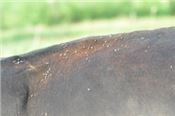Horn Fly: The $1 Billon Insect

Figure 1. Horn flies feed along the back and sides of pastured cattle, leaving only to lay eggs or
move to a different host animal.
Photo: Lee Townsend, UK
DR. LEE TOWNSEND
LEXINGTON, KY.
Horn flies are important pests of pastured cattle (Figure 1). They use their piercing-sucking mouthparts to take about 30 blood meals every day. The almost incessant feeding of large populations can severely impact growing calves and lactating cows. Horn flies may also be involved in disease transmission. These insects suck about $1 billion dollars in weight gain/milk production losses and control costs each season.
Management
The close association between horn flies and cattle helps with control. The flies leave animals only to lay eggs in fresh cow manure or to change hosts. Consequently, most any of a variety of application methods will expose flies to insecticide residues. Alternatives include forced-use dust bags or back rubbers, insecticidal ear tags, sprays, and pour-on formulations.
Avoiding Development of Insecticide Resistance
Rapid development of insecticide resistance makes horn fly control challenging, with no clear-cut strategies that solve the problem. Insecticide resistance may develop following the use of insecticides from the same mode of action group for several consecutive years or by immigration of resistant flies from nearby herds.
Differences among flies in a population may include ability to metabolize or detoxify insecticides quickly or have altered target sites in their nervous systems that insecticides do not effectively block. In addition, flies that are very sensitive to some insecticide residues can detect them and move to an untreated area on the animal before picking up a lethal dose.
Surviving females lay groups of about 15 eggs at a time (up to 200 total) in very fresh cow manure. Under ideal conditions, development from egg to adult can take as little as 10 to 14 days. This means several generations a year in most parts of the U.S. Consequently, selection for genetic factors that favor fly survival can occur relatively quickly. Finally, newly emerged horn flies may travel 5 to 7 miles in search of cattle. This led to a dispersal of resistant flies over an increasingly wider area.
Resistance management recommendations include:
1) Do not treat for horn flies unless or until numbers exceed 200 per animal. Cattle can tolerate up to this level before economic losses occur.
2) If feasible, keep growing calves and lactating cows separated from mature stock. Fly reduction on growing and lactating animals is more likely to provide an economic return.
3) Use periodic treatments with insecticides that have other modes of action (organophosphates, etc.) to break fly exposure to a single product group. Rotating products with different modes of action is a basic strategy that may reduce the potential for resistance.
4) Remove ear tags in fall to reduce horn fly exposure to low concentrations of pyrethroids.
5) Use a late season application to reduce the number of horn flies that will enter the over-wintering stage on the farm.
A good indication resistant flies are present is no noticeable fly reduction within two weeks of applying tags. ∆
DR. LEE TOWNSEND: Extension Entomologist, University of Kentucky